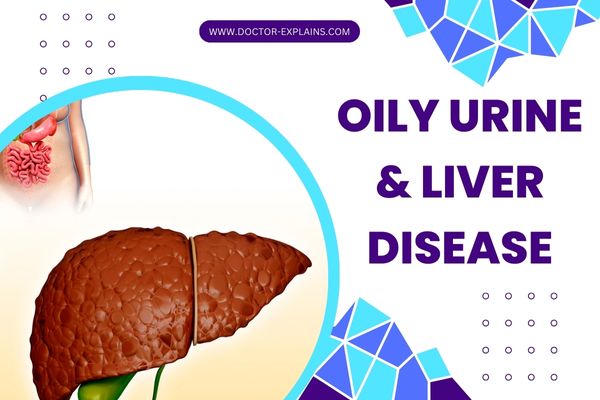Key Facts:
- Cloudy and oily urine is a term used to describe when urine has an oil film or rainbow pattern.
- The oily appearance of urine is not necessarily caused by oils or fats in the urine itself.
- Several factors can contribute to this appearance, such as dehydration, some supplements, and contamination with genital secretions.
- There are different causes of turbid oily urine, including Chyluria, Nephrotic Syndrome, UTI, sexually-transmitted infections, prostatic problems, and others.
- Diagnosing the cause of cloudy or oily urine may include a physical examination of the urine sample, blood tests, imaging studies, cystoscopy, and specific tests to diagnose the underlying causes.
- See a doctor if you have persistent abnormal oily and cloudy urine or if the condition is associated with certain symptoms.
What is cloudy and oily urine?
Oily urine is a term used to describe when urine has an oil film or rainbow pattern, making it look like an oil slick on the surface of the toilet or container. It can also appear as darker yellow oily drops on the surface of the urine. Some people may describe slightly turbid urine as oily or fatty urine.
It’s important to note that the oily appearance of urine is not necessarily caused by oils or fats in the urine itself. Several factors can contribute to this appearance, such as dehydration, some supplements, and contamination with genital secretions.
What causes turbid oily urine?
[1] Chyluria.
The lymphatic fluid is a collection of high-fat and high-protein fluid that drains from cells and tissues (mainly the intestines).
In some conditions, the lymphatic tissues pass into urine through the kidneys leading to milky (turbid) urine with an oily look due to its high fat and protein content.
Causes:
Common causes of Chyluria are summarized in the table below (reference):
| Parasitic infections | Non-parasitic Causes |
|---|---|
| Wuchereria bancroft (in 95% of cases | Trauma to the kidneys or abdomen |
| Taenia echinococcus | Surgery such as partial kidney removal and aortoiliac bypass. |
| taenia Nana | Infections/ |
| Ankylostoma infection | Malignant tumors |
| Trichiniasis | Lymphatic Malformation |
| Malaria | Radiation |
| Access | |
| Birth defects in the urinary tract. | |
| Pregnancy | |
| Thoracic duct obstruction (the main lymphatic duct). |
Symptoms of Chyluria:
- Unclear (turbid or cloudy) urine ranges from mild cloudiness to opaque milky white urine in severe cases.
- A fatty or oily look of urine.
- Painful urination (dysuria).
- Sudden urge to urinate.
- Blood or blood clots in urine.
- Inability to pass urine in some cases (urine retention).
- Weight loss.
- Edema (swelling) of the limbs, abdomen, or face.
- Massive lower limb edema is common with Filariasis (Wuchereria bancrofti infection).
[2] Nephrotic Syndrome.
Normally, your kidney doesn’t allow proteins (such as albumin) to pass in urine (except for trace amounts).
However, some kidney diseases may lead to massive loss of protein in the urine leading to oily, foamy, and cloudy urine, a condition called (nephrotic syndrome).
Common Causes (reference):
- Diabetes mellitus (long-lasting diabetes that causes damage to the kidneys).
- Glomerular diseases such as membranous glomerulonephritis, Minimal change disease, etc.
- Systemic lupus (a disease common in females and affects the kidney in many cases leading to lupus nephritis).
- Other Immune-medicated diseases, such as Vasculitis, acute post-streptococcal glomerulonephritis, etc.
- Some drugs, such as NSAIDs toxicity, Lithium, and gold salts.
- Some infections, such as HIV, Hepatitis B virus, Hepatitis C virus, Cytomegalovirus, etc.
Symptoms:
- Swelling of the face (morning puffiness of eyelids) is the first sign, especially in children).
- Foamy urine (bubbles on the surface of urine).
- Urine may become lighter in color (diluted) due to excess urine.
- Slightly cloudy or turbid urine.
- Urine may also look oily due to the passage of some fats with the protein in the urine.
- Swollen limbs or abdomen.
- Fatigue or headaches.
- Weight gain or weight loss.
- Pallor.
[3] UTI
Urinary tract infections (UTIs) are one of the most common urinary tract diseases, particularly among women. Urinary tract infection is either simple (bladder infection) or complicated (infection extending to the kidneys or the bloodstream).
Causes & risk factors of UTI:
- Bacteria from the stool (Escherichia coli is the most common).
- Sexual activities (such as frequent intercourse).
- Hormonal changes during menopause.
- Use of urinary catheter or recent urologic procedure.
- Urinary obstruction (such as kidney stones).
- Immune-mediated conditions (such as Sjogren’s syndrome).
- Diabetes and other metabolic disorders.
- Genetics (some people may have an increased risk of developing UTIs).
Symptoms:
- A strong, persistent urge to urinate
- A burning sensation when urinating
- Passing frequent, small amounts of urine
- Urine that appears cloudy and oily.
- Strong-smelling urine
- Pelvic pain in women
- Blood in the urine (hematuria) or small blood clots in urine.
- Complicated urinary infections (that extend from the bladder to the kidney) may cause loin pain, fever, or chills.
[4] Sexually-transmitted Infections.
Sexually transmitted infections (STIs) are infections that can be passed from one person to another through sexual contact. They can be caused by bacteria, viruses, or parasites.
Common STIs include
- chlamydia,
- gonorrhea,
- syphilis,
- genital herpes,
- human papillomavirus (HPV),
- and HIV.
Symptoms:
Symptoms of sexually transmitted infections (STIs) vary depending on the specific infection but can include:
- Pain during sexual intercourse.
- Unusual discharge (Vaginal, anorectal, or genital).
- sores, bumps, or rashes in the genital area
- fever
- fatigue
- swollen lymph nodes
- bleeding or pain during urination or bowel movements
- itching or burning in the genital area
- general discomfort or flu-like symptoms
[5] Prostatic problems.
Symptoms of prostatitis may include:
- Pain or discomfort in the genital area, groin, or lower back
- Painful or burning urination
- Frequent urination, especially at night
- Difficulty starting urination or holding back urine
- Weak urine stream or interrupted urine flow
- Blood in the urine or seminal fluid
- Pain during ejacuIation
- Erectile dysfunction
- Fever and chills (if caused by a bacterial infection)
[6] Others.
Other causes of turbid oily urine may also include:
- Contamination with genital secretions (seminal fluid, prostatic secretions, or vaginal secretions).
- Contamination of urine with toilet detergents.
- Bladder or kidney cancer.
- Kidney or bladder stones.
- Severe dehydration.
- Severe ketosis (in diabetic ketoacidosis and strict keto diet).
Diagnosis of the cause of cloudy oily urine
Your doctor may perform one or more of the following to identify the cause of oily and cloudy urine:
- Physical examination of the urine sample under a microscope and chemical testing to check for fats, proteins, and other abnormalities.
- Blood tests to check for kidney function, lipid levels, and other metabolic abnormalities.
- Imaging studies such as ultrasound, CT scan, or MRI to evaluate the kidney and bladder.
- Cystoscopy to examine the inside of the bladder and urethra.
- Specific tests to diagnose the underlying causes such as urine culture and sensitivity, testing for parasitic infections, and albumin/creatinine ratio in urine.
When to see a doctor for oily and cloudy urine?
See a doctor if you have persistent abnormal oily and cloudy urine or if the condition is associated with:
- Milky white urine.
- Sweet urine smell (ketonuria).
- Dysuria (painful urination).
- Scanty urine (oliguria) or too much urine (polyuria).
- Foamy urine.
- Turbid or bloody urine.
- Swelling of your legs, eyelids, or your abdomen.
- Fever or chills.
- Obstruction of urine (retention).
- Severe urinary bladder (lower abdominal pain) or loin pain.





